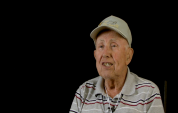4:00 | Nicholas Sawicke was a lucky man. The B-17 gunner finished the required missions without any aircraft he was on suffering a mishap. His pilot, who was out for a few missions, had to stay on longer than the gunner to finish his tour. He was not so lucky.
Keywords : Nicholas Sawicke gunner Boeing B-17 Flying Fortress 20 mm gun anti-aircraft (AA) German fighter parachute (chute) bail out

Nicholas Sawicke was from a tiny rural community and when he was old enough for high school, it was sports that gave him the discipline to succeed. When the draft came after Pearl Harbor, his test scores put him in the Air Corps.
The majority of his training was as a gunner, but Nicholas Sawicke had to learn much more than that. The B-17 had a lot of systems and he had to know what to do when any situation arose.
The men of the 306th Bomb Group crossed the Atlantic on the RMS Queen Elizabeth and settled into a hastily constructed base in the English countryside. Right away, gunner Nicholas Sawicke did not like the place or the food.
B-17 gunner Nicholas Sawicke's first mission was to hit some submarine pens on the French coast. As the missions moved across France and then into Germany, fighter escort became harder to come by. The airmen had to face the anti-aircraft fire and the German fighters with their own firepower.
On your return flight, if your bomber fell out of the formation due to damage or mechanical trouble, you were a sitting duck for the German fighters. Gunner Nicholas Sawicke recalls that, if you had to abandon the first target and go to a secondary target, that put you out there in their reach for even longer. There was flak too, and he has the souvenir to prove it.
On his last mission, B-17 gunner Nicholas Sawicke was a little more anxious than usual, but it ended without incident. His tour was relatively early in the war and, when he returned, this made him a subject of much curiosity in the local newspapers.